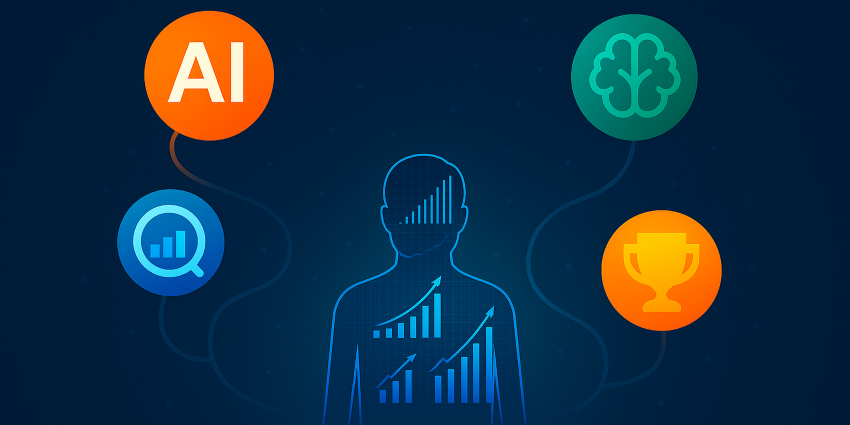Despite the hype, the promises and the eye-watering investment, most organisations are still struggling to turn their artificial intelligence ambitions into meaningful results.
According to Cisco’s latest AI Readiness Report, just 13 percent of companies qualify as genuinely ‘AI-ready’ – a figure that has barely moved in three years.
For all the enthusiasm about generative models and agentic systems, the great AI transformation is advancing more slowly than its cheerleaders might admit.
“Everybody’s going, ‘We need to do something; AI’s going to help us,’” Rob Lay, Director, Solutions Engineering, UK&I at Cisco told UC Today.
“But not a massive number of companies have really identified those use cases that are going to drive revenue and value back into the business.”
In other words, the problem is not a lack of ambition but a lack of clarity.
While around 18 percent of firms have nailed down specific use cases and moved them through pilot stages, more than half are still in the realm of experimentation – tentatively testing proofs of concept without a clear route to scale.
The Pace-setters
The result is a widening gap between what Cisco calls “pace-setters” – organisations that have made AI central to their operations – and everyone else.
According to Cisco, these pace-setters are four times more likely to move AI projects into production and 50 percent more likely to see tangible business results.
Their secret is not simply spending more, but integrating AI into the core of their business rather than treating it as a side project.
“They’ve made AI a core part of the business,” Lay explains.
“They’ve put investment into the infrastructure, the business processes, and the measurement frameworks to show return on investment. They’ve got everything lined up – from use cases to governance – to move from pilot to production.”
From Proof of Concept to Profit
Cisco’s research highlights several verticals where AI is already paying dividends.
Financial services firms are using it to detect and prevent fraud. Pharmaceutical companies are deploying machine learning to accelerate drug discovery and clinical research. And in retail, AI is increasingly being used to personalise customer engagement.
Retailers in the pace-setter bracket, Lay notes, are going far beyond the basic “people who bought this also bought that” recommendation engines.
“They’re developing genuine AI capabilities that engage customers through chatbots, analyse buying profiles, and deliver tailored recommendations. It’s much more specific to the individual.”
That specificity is translating into stronger customer relationships – and, crucially, new revenue streams.
Cisco’s report found that 71 percent of pace-setters are confident AI will generate new revenue, compared with just 34 percent of companies overall.
In pharmaceuticals, the benefits are similarly tangible.
AI is cutting years off R&D cycles by simulating molecular interactions and analysing vast datasets of clinical results.
In oil and gas, meanwhile, it is being used to analyse geological and seismic data to identify drilling locations with greater accuracy.
While Lay admits he’s “not an oil and gas expert per se,” he notes that AI systems are increasingly able to narrow exploration zones without costly and environmentally damaging test drilling.
“They’re able to refine the areas they’re looking at through AI and the way they leverage data. It’s saving them money by improving the probability of success.”
The Agentic Revolution
Perhaps the most striking finding in the report is that 83 percent of companies plan to deploy AI agents – autonomous systems capable of taking actions on behalf of humans – and 40 percent expect them to work alongside employees within a year.
That rapid shift, Lay insists, is not primarily about cutting costs.
“It’s about improving customer engagement,” he says. Cisco itself uses AI agents in its technical support operations to handle low-severity cases – routine queries and documentation requests – freeing up engineers to focus on complex issues that genuinely require human expertise.
“What we’ve been able to do is reduce the time to resolution for customers at the lower end, while allowing engineers to deal with the trickier cases,” he explains. “It’s not about cost saving; it’s about improving satisfaction.”
That said, not everyone welcomes the march of the bots.
Customers have long complained about impersonal, scripted chatbots that fail to understand their needs.
Lay acknowledges that risk, but believes modern AI systems – with their more natural language capabilities – can overcome it.
“The little chatbots that have appeared on websites for years could be frustrating,” he concedes.
“But with large language models, the responses are much less robotic. It’s much more conversational. We’ve actually seen an increase in customer satisfaction through AI agents. The key is implementing them the right way.”
A New Kind of Debt
Even companies eager to embrace AI face an emerging challenge: AI infrastructure debt.
Similar to the concept of technical debt in software development, this refers to the cumulative effect of outdated or overstretched systems that cannot handle the demands of modern AI workloads.
“It’s massively serious,” Lay says. “AI places far higher demands on infrastructure. When you move into an agentic world, the requirement becomes much more constant. It’s the accumulation of all those little decisions – ‘we’ll sweat that asset a bit longer’, or ‘we’ll delay the upgrade’ – that add up to a significant gap between where the infrastructure is and where it needs to be.”
The consequence is that companies can find themselves unable to scale promising pilots into production because their networks, data pipelines or compute capacity are simply not up to the task.
“That gap is quite considerable – and it can make the difference between getting a return on investment and not.”
The Data Dilemma
Infrastructure is not the only bottleneck – data fragmentation remains a chronic problem for enterprises pursuing AI maturity.
Some 64 percent of organisations in Cisco’s report said they struggle to centralise their data – a fundamental obstacle when AI models rely on large, consistent and accessible datasets.
“Ten years ago, if you asked a company where its data was, you’d often get confused looks,” Lay notes.
“AI is driving more awareness, but organisations still need to understand and manage their data more effectively.”
Complicating matters is the growing trend toward distributed computing. Data centres, constrained by power and planning limitations, are increasingly decentralised.
“We’re seeing data centres become less geographically concentrated,” Lay explains. “That changes how you connect them, how you move data efficiently between them.”
For AI to deliver value, Lay says data must be both available and fast to access – whether stored centrally or across multiple sites.
“It’s about ensuring that the models or engines can get to the data in an efficient way.”
Building Security In
Security is another differentiator between pace-setters and those lagging behind.
The report found that 87 percent of leading companies are highly aware of AI-specific threats, compared with just 42 percent of firms overall.
Those at the forefront, Lay says, are embracing “secure by design” principles – building protections into systems from the outset rather than bolting them on later. “That’s never really worked, and it definitely doesn’t work with AI.”
He points to two specific areas of focus: maintaining effective guardrails as models evolve, and defending against prompt injection – malicious attempts to manipulate AI outputs.
“You have to keep guardrails up to date as you tune models,” he explains. “And you need technologies that detect when someone’s trying to get the model to do something malicious.”
He cites a peculiar example from academia, where researchers tricked a model into answering questions as if it were a hamster.
“It’s a daft example, but it shows how prompt injection could be dangerous if used for something malicious.”
Resilience in an AI World
The recent AWS outage, which knocked out major online services, was a reminder of how dependent the modern economy has become on digital infrastructure.
As AI becomes similarly foundational, does that not pose a new systemic risk?
“It’s a fair question,” Lay says. “That AWS issue seemed to stem from a DNS problem – DNS has been around since the dawn of the internet. It shows how dependent we already are on technology. AI is part of that broader picture. The focus has to be on digital resilience overall.”
So what can companies do to join the 13 percent who are genuinely AI-ready? Lay offers two pieces of advice.
“First, identify whether you have any AI infrastructure debt, and take sensible steps to move towards an infrastructure that’s ready for AI. That’s the top one. Second, really nail down your use cases. Those two things go hand in hand.”
Becoming AI-ready, in other words, is less about buying the latest model and more about getting the foundations right – data, infrastructure, processes and purpose.
The firms that understand that will be the ones still standing when the hype dies down.







